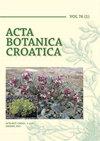中球形藻在渗透调节和盐胁迫下的植物发育、气体交换和色素
IF 0.7
4区 生物学
Q3 PLANT SCIENCES
引用次数: 1
摘要
盐胁迫是影响作物生长发育的主要非生物胁迫之一。因此,寻找能够将盐度造成的损害降至最低的技术至关重要。本文研究了盐胁迫和种子渗透调节对中叶草(mesosphere suaveolens)生物量、气体交换和叶绿素色素的影响。Kuntze。统计设计采用随机区组设计,参照灌溉水电导率和渗透电位,按中央组合设计(CentralComposite design)组合,最小(- α)和最大(α)值分别为0.5和10.0 dS m-1, 0.0和-1.0 MPa,共9组。在开始盐水灌溉后45 d,对干生物量、气体交换和叶绿素指数进行测定。灌溉水含盐量严重影响了水杨的干生物量和气体交换。电导率在3.2 dS - m-1以上的灌溉水降低了紫叶青植株叶绿素a、b和总含量。种子渗透调节并没有减弱盐胁迫对藜麦植株的负面影响。本文章由计算机程序翻译,如有差异,请以英文原文为准。
Plant development, gas exchanges and pigments of Mesosphaerum suaveolens submitted to osmoconditioning and saline stress
Salinity is one of the main plant abiotic stresses which affects the establishment and development crops. Hence, the search for technologies that minimize the damage caused by salinity is essential. The aim of the
present work was to evaluate the effect of salinity stress and osmotic conditioning of seeds on the biomass, gas exchanges and chlorophyll pigments in Mesosphaerum suaveolens (L.) Kuntze. The statistical design adopted was a randomized block design, combined according to the Central
Composite Design, referring to electrical conductivities of irrigation water and osmotic potentials, with minimum (- α) and maximum (α) values of 0.5 and 10.0 dS m-1 and 0.0 and -1.0 MPa, respectively, totaling nine
combinations. The characteristics of dry biomass, gas exchange and chlorophyll indices were evaluated at 45 days after irrigation with saline water started. The salinity of irrigation water severely affected
the dry biomass and the gas exchanges of M. suaveolens. Irrigation water of electrical conductivity above 3.2 dS m-1 caused reductions in chlorophyll a, b and total contents in M. suaveolens plants. Seed osmoconditioning did not attenuate the negative effects of saline stress
on M. suaveolens plants.
求助全文
通过发布文献求助,成功后即可免费获取论文全文。
去求助
来源期刊

Acta Botanica Croatica
PLANT SCIENCES-
CiteScore
2.50
自引率
0.00%
发文量
34
审稿时长
>12 weeks
期刊介绍:
The interest of the journal is field (terrestrial and aquatic) and experimental botany (including microorganisms, plant viruses, bacteria, unicellular algae), from subcellular level to ecosystems. The attention of the Journal is aimed to the research of karstic areas of the southern Europe, karstic waters and the Adriatic Sea (Mediterranean).
 求助内容:
求助内容: 应助结果提醒方式:
应助结果提醒方式:


